Abstract
We have investigated the role of CD4 molecules in intrathymic T-cell repertoire selection. The administration of monoclonal antibody (mAb) to CD4 in organ culture of murine foetal thymus (FTOC) completely inhibited the development of CD4+8- cells, and additional treatment with anti-class II MHC (Ia) mAb caused no further effects on this inhibition. On the other hand, when the potentially autoreactive cells in Mls-1a mice were monitored by expression of the Mls-1a-reactive V beta 6 gene product of T-cell receptor alpha beta (TcR alpha beta), the treatment with anti-CD4 resulted in the appearance of V beta 6-bearing cells to some extent, but this effect was considerably reinforced by the combinatory use of anti-Ia mAb with anti-CD4. In a model system where the bacterial superantigen staphylococcal enterotoxin B serves as self-antigen to deplete V beta 8-bearing cells in FTOC, the depletion of V beta 8+ cells was restored partially by anti-CD4 alone but completely by the combination with anti-Ia. These results suggest that CD4 is indispensable for positive selection of all CD4+8- thymocytes, whereas participation of CD4 in negative selection is only partial. It was also observed that the development of TcR alpha beta-bearing cells in the CD4-8- population was inhibited by the treatment with anti-CD4 mAb. In Mls-1a mice, V beta 6-bearing cells were developed in CD4-8+, CD4+8+, and also in CD4-8- populations after anti-CD4 mAb treatment. It is suggested that TcR alpha beta-bearing CD4-8- cells are possibly originated from CD4+ cells and undergo CD4-mediated thymic selection.
Full text
PDF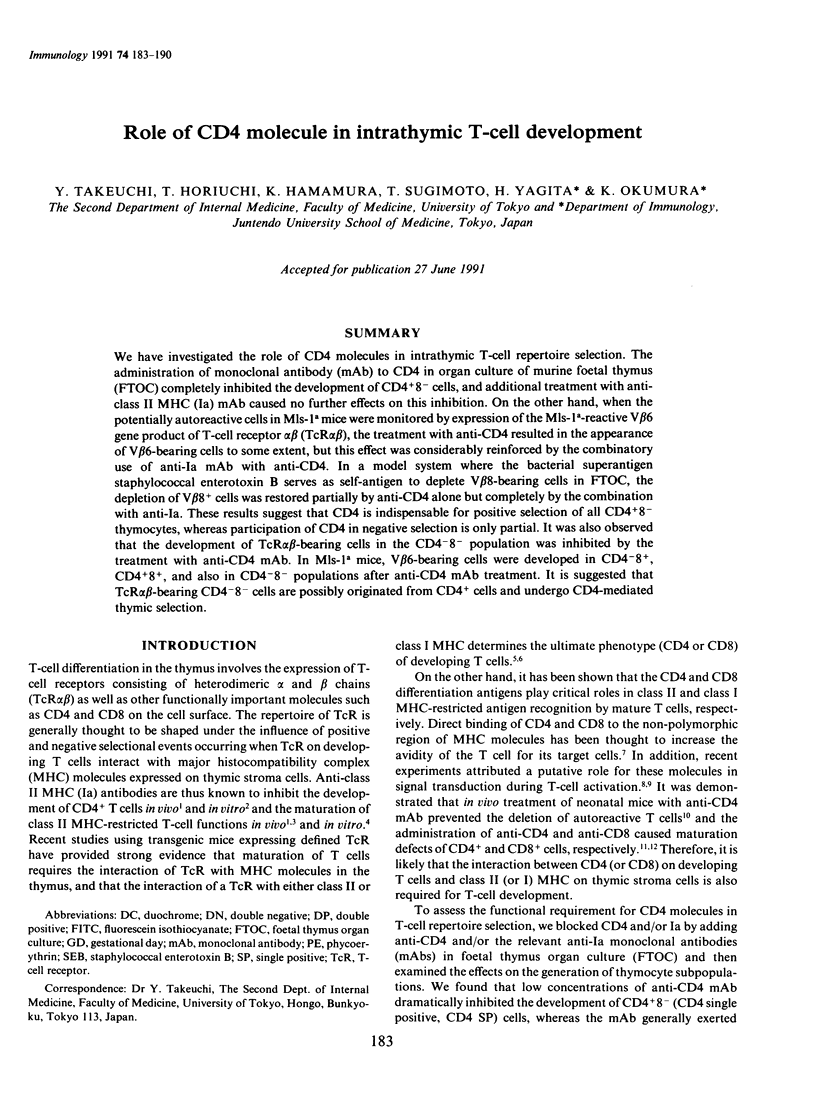
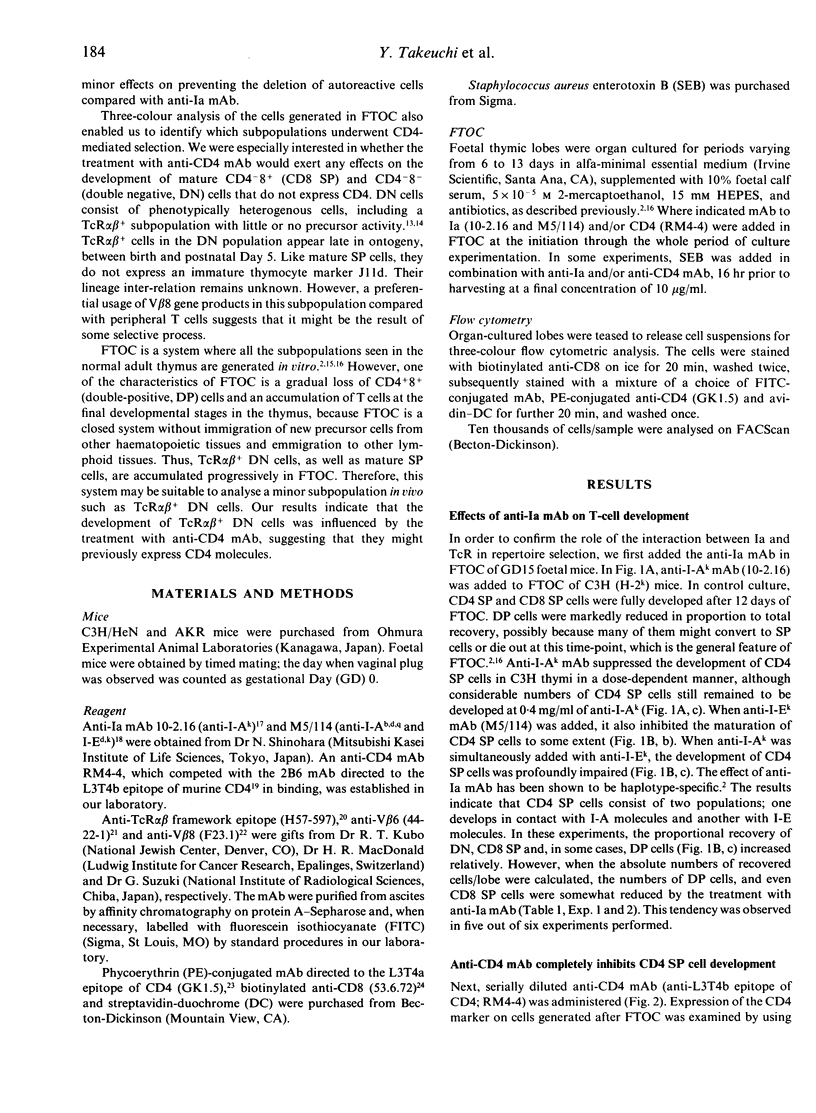
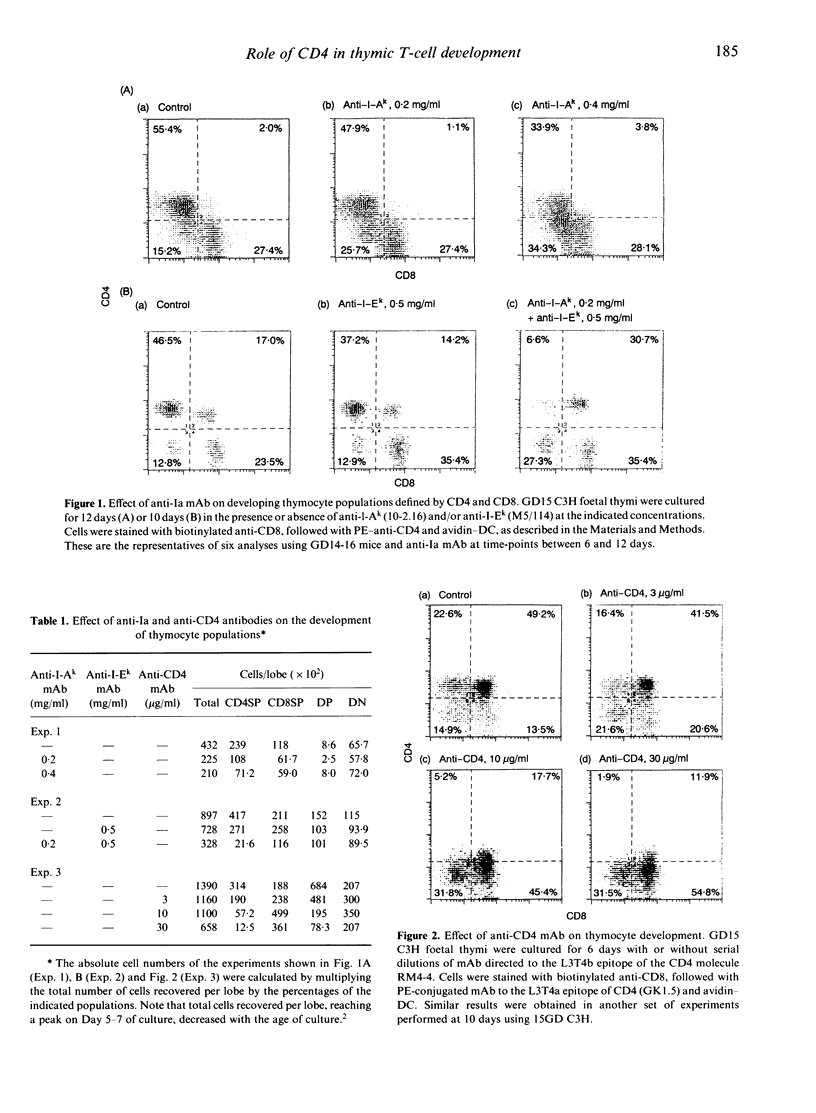
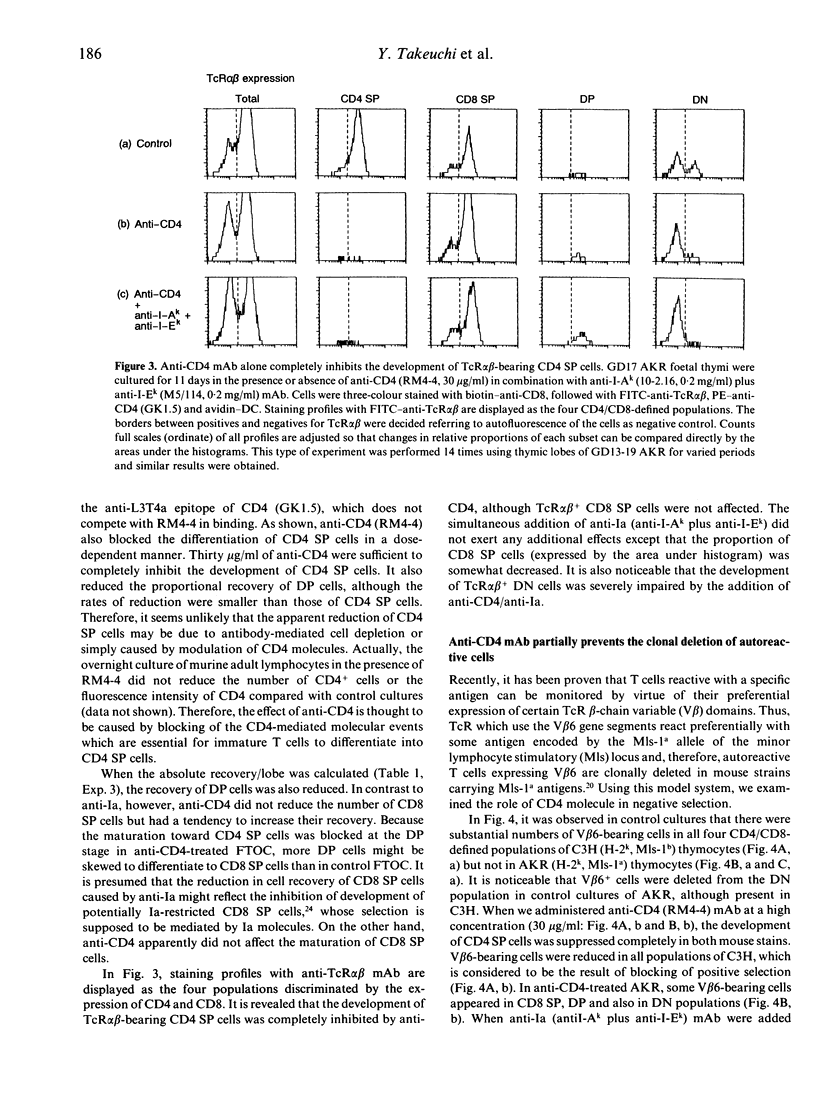
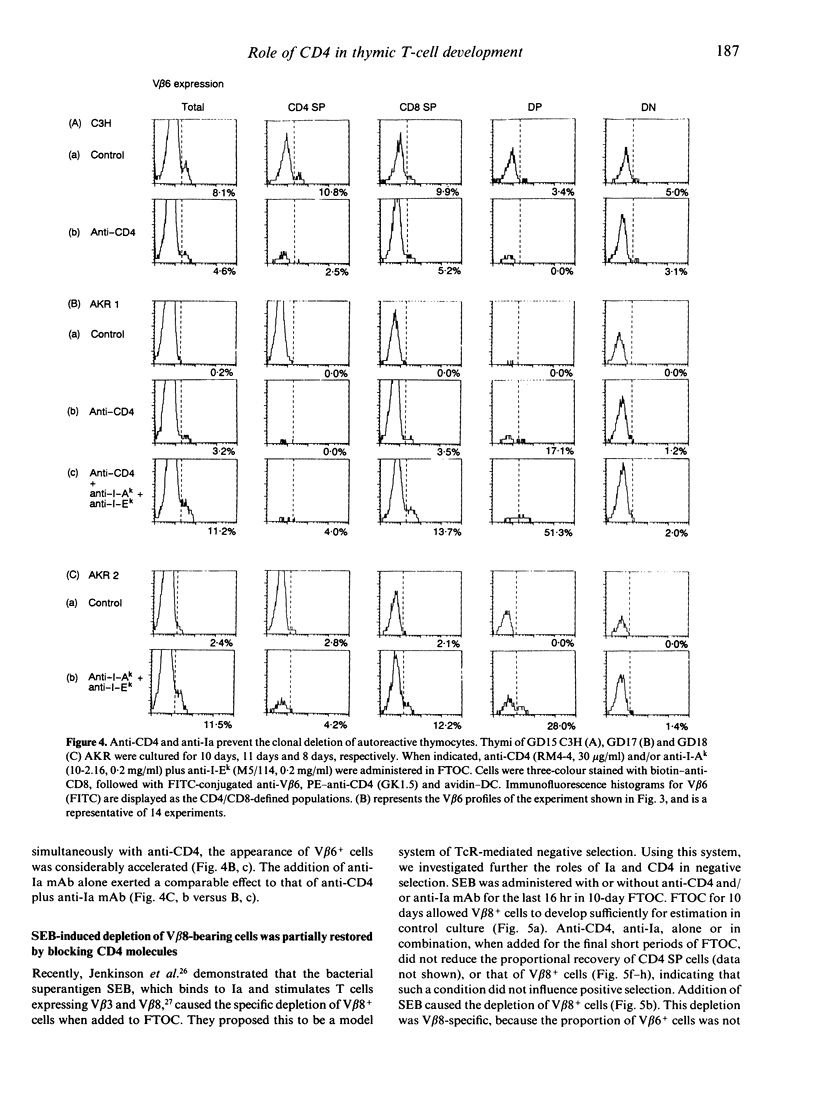
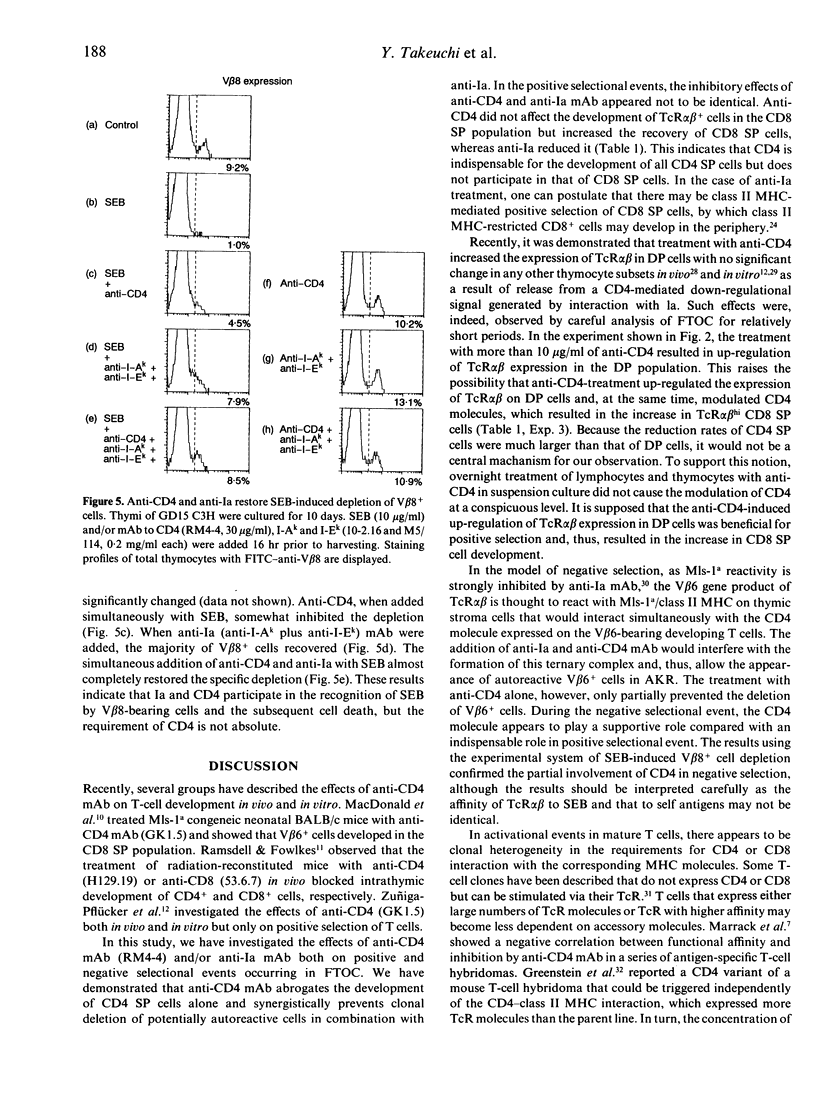
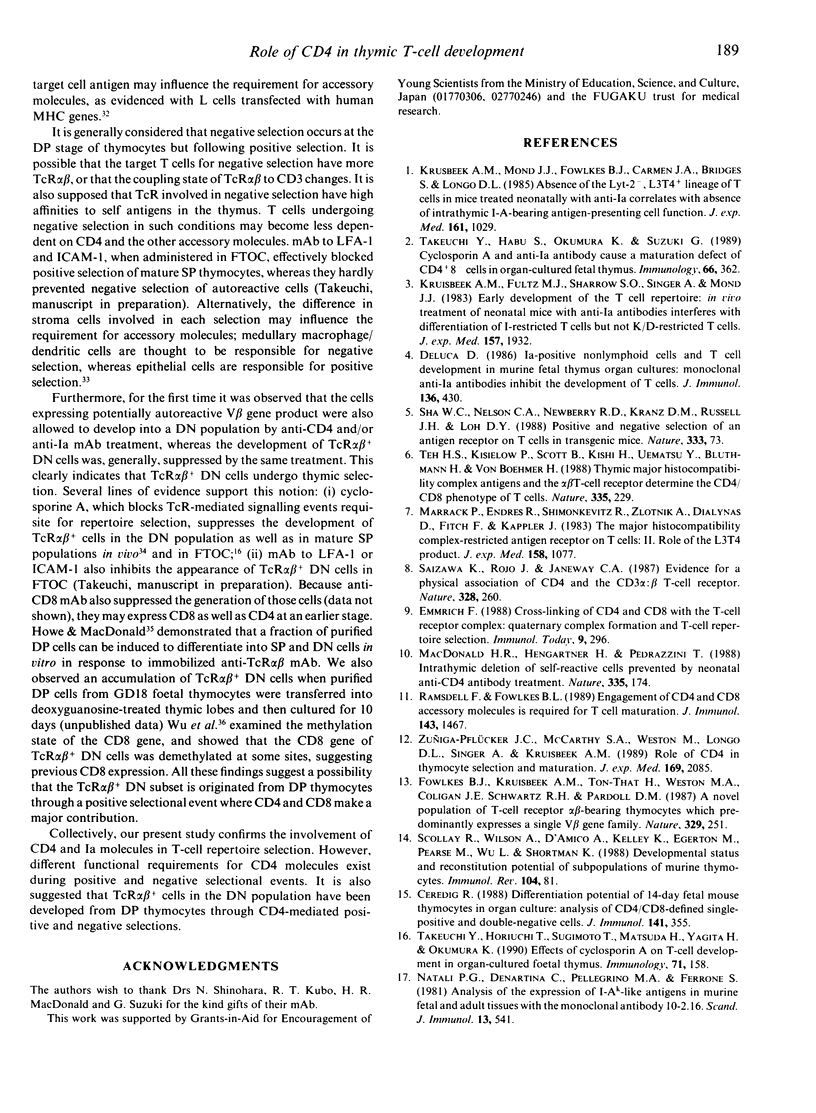
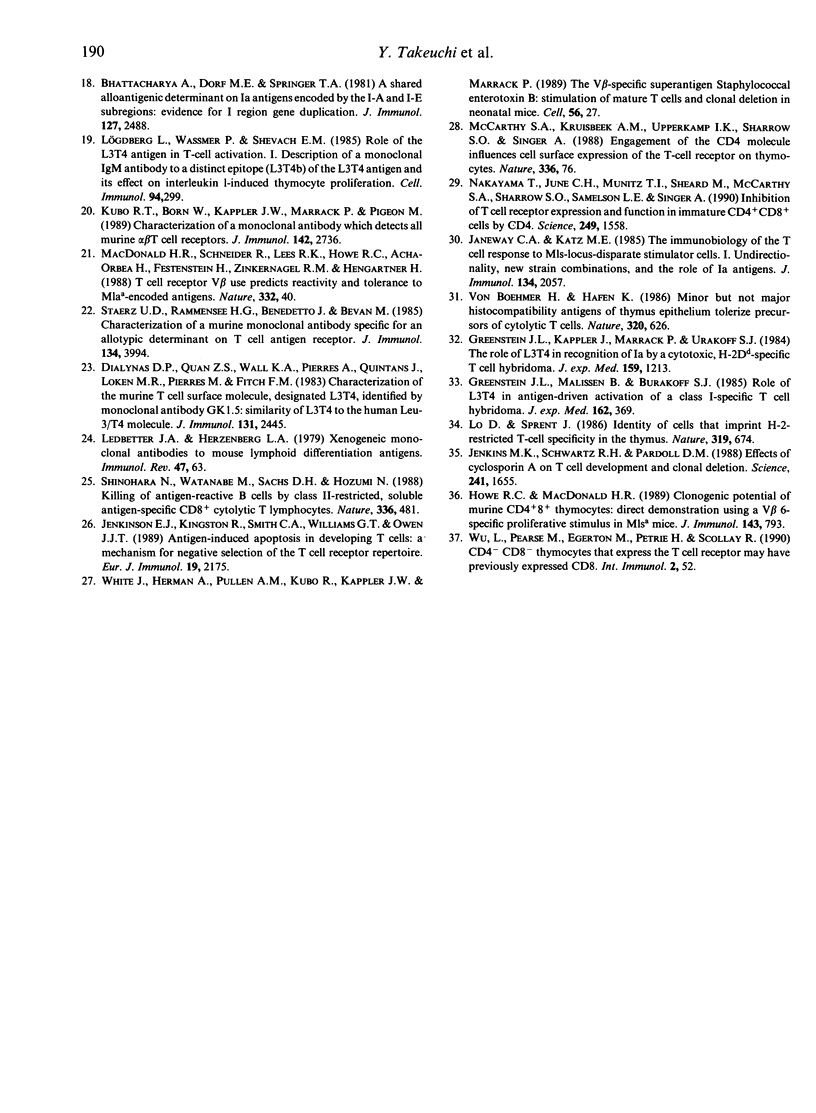
Selected References
These references are in PubMed. This may not be the complete list of references from this article.
- Bhattacharya A., Dorf M. E., Springer T. A. A shared alloantigenic determinant on Ia antigens encoded by the I-A and I-E subregions: evidence for I region gene duplication. J Immunol. 1981 Dec;127(6):2488–2495. [PubMed] [Google Scholar]
- Ceredig R. Differentiation potential of 14-day fetal mouse thymocytes in organ culture. Analysis of CD4/CD8-defined single-positive and double-negative cells. J Immunol. 1988 Jul 15;141(2):355–362. [PubMed] [Google Scholar]
- DeLuca D. Ia-positive nonlymphoid cells and T cell development in murine fetal thymus organ cultures: monoclonal anti-Ia antibodies inhibit the development of T cells. J Immunol. 1986 Jan;136(2):430–439. [PubMed] [Google Scholar]
- Dialynas D. P., Quan Z. S., Wall K. A., Pierres A., Quintáns J., Loken M. R., Pierres M., Fitch F. W. Characterization of the murine T cell surface molecule, designated L3T4, identified by monoclonal antibody GK1.5: similarity of L3T4 to the human Leu-3/T4 molecule. J Immunol. 1983 Nov;131(5):2445–2451. [PubMed] [Google Scholar]
- Emmrich F. Cross-linking of CD4 and CD8 with the T-cell receptor complex: quaternary complex formation and T-cell repertoire selection. Immunol Today. 1988 Oct;9(10):296–300. doi: 10.1016/0167-5699(88)91320-5. [DOI] [PubMed] [Google Scholar]
- Fowlkes B. J., Kruisbeek A. M., Ton-That H., Weston M. A., Coligan J. E., Schwartz R. H., Pardoll D. M. A novel population of T-cell receptor alpha beta-bearing thymocytes which predominantly expresses a single V beta gene family. Nature. 1987 Sep 17;329(6136):251–254. doi: 10.1038/329251a0. [DOI] [PubMed] [Google Scholar]
- Greenstein J. L., Kappler J., Marrack P., Burakoff S. J. The role of L3T4 in recognition of Ia by a cytotoxic, H-2Dd-specific T cell hybridoma. J Exp Med. 1984 Apr 1;159(4):1213–1224. doi: 10.1084/jem.159.4.1213. [DOI] [PMC free article] [PubMed] [Google Scholar]
- Greenstein J. L., Malissen B., Burakoff S. J. Role of L3T4 in antigen-driven activation of a class I-specific T cell hybridoma. J Exp Med. 1985 Jul 1;162(1):369–374. doi: 10.1084/jem.162.1.369. [DOI] [PMC free article] [PubMed] [Google Scholar]
- Howe R. C., MacDonald H. R. Clonogenic potential of murine CD4+8+ thymocytes. Direct demonstration using a V beta 6-specific proliferative stimulus in Mlsa mice. J Immunol. 1989 Aug 1;143(3):793–797. [PubMed] [Google Scholar]
- Janeway C. A., Jr, Katz M. E. The immunobiology of the T cell response to Mls-locus-disparate stimulator cells. I. Unidirectionality, new strain combinations, and the role of Ia antigens. J Immunol. 1985 Apr;134(4):2057–2063. [PubMed] [Google Scholar]
- Jenkins M. K., Schwartz R. H., Pardoll D. M. Effects of cyclosporine A on T cell development and clonal deletion. Science. 1988 Sep 23;241(4873):1655–1658. doi: 10.1126/science.241.4873.1655. [DOI] [PubMed] [Google Scholar]
- Jenkinson E. J., Kingston R., Smith C. A., Williams G. T., Owen J. J. Antigen-induced apoptosis in developing T cells: a mechanism for negative selection of the T cell receptor repertoire. Eur J Immunol. 1989 Nov;19(11):2175–2177. doi: 10.1002/eji.1830191132. [DOI] [PubMed] [Google Scholar]
- Kruisbeek A. M., Fultz M. J., Sharrow S. O., Singer A., Mond J. J. Early development of the T cell repertoire. In vivo treatment of neonatal mice with anti-Ia antibodies interferes with differentiation of I-restricted T cells but not K/D-restricted T cells. J Exp Med. 1983 Jun 1;157(6):1932–1946. doi: 10.1084/jem.157.6.1932. [DOI] [PMC free article] [PubMed] [Google Scholar]
- Kruisbeek A. M., Mond J. J., Fowlkes B. J., Carmen J. A., Bridges S., Longo D. L. Absence of the Lyt-2-,L3T4+ lineage of T cells in mice treated neonatally with anti-I-A correlates with absence of intrathymic I-A-bearing antigen-presenting cell function. J Exp Med. 1985 May 1;161(5):1029–1047. doi: 10.1084/jem.161.5.1029. [DOI] [PMC free article] [PubMed] [Google Scholar]
- Kubo R. T., Born W., Kappler J. W., Marrack P., Pigeon M. Characterization of a monoclonal antibody which detects all murine alpha beta T cell receptors. J Immunol. 1989 Apr 15;142(8):2736–2742. [PubMed] [Google Scholar]
- Ledbetter J. A., Herzenberg L. A. Xenogeneic monoclonal antibodies to mouse lymphoid differentiation antigens. Immunol Rev. 1979;47:63–90. doi: 10.1111/j.1600-065x.1979.tb00289.x. [DOI] [PubMed] [Google Scholar]
- Lögdberg L., Wassmer P., Shevach E. M. Role of the L3T4 antigen in T-cell activation. I. Description of a monoclonal IgM antibody to a distinct epitope (L3T4b) of the L3T4 antigen and its effect on interleukin 1-induced thymocyte proliferation. Cell Immunol. 1985 Sep;94(2):299–311. doi: 10.1016/0008-8749(85)90254-0. [DOI] [PubMed] [Google Scholar]
- MacDonald H. R., Hengartner H., Pedrazzini T. Intrathymic deletion of self-reactive cells prevented by neonatal anti-CD4 antibody treatment. Nature. 1988 Sep 8;335(6186):174–176. doi: 10.1038/335174a0. [DOI] [PubMed] [Google Scholar]
- Marrack P., Endres R., Shimonkevitz R., Zlotnik A., Dialynas D., Fitch F., Kappler J. The major histocompatibility complex-restricted antigen receptor on T cells. II. Role of the L3T4 product. J Exp Med. 1983 Oct 1;158(4):1077–1091. doi: 10.1084/jem.158.4.1077. [DOI] [PMC free article] [PubMed] [Google Scholar]
- Nakayama T., June C. H., Munitz T. I., Sheard M., McCarthy S. A., Sharrow S. O., Samelson L. E., Singer A. Inhibition of T cell receptor expression and function in immature CD4+CD8+ cells by CD4. Science. 1990 Sep 28;249(4976):1558–1561. doi: 10.1126/science.2120773. [DOI] [PubMed] [Google Scholar]
- Natali P. G., De Martino C., Pellegrino M. A., Ferrone S. Analysis of the expression of I-Ak-like antigens in murine fetal and adult tissues with the monoclonal antibody 10-2.16. Scand J Immunol. 1981;13(6):541–546. doi: 10.1111/j.1365-3083.1981.tb00167.x. [DOI] [PubMed] [Google Scholar]
- Ramsdell F., Fowlkes B. J. Engagement of CD4 and CD8 accessory molecules is required for T cell maturation. J Immunol. 1989 Sep 1;143(5):1467–1471. [PubMed] [Google Scholar]
- Saizawa K., Rojo J., Janeway C. A., Jr Evidence for a physical association of CD4 and the CD3:alpha:beta T-cell receptor. Nature. 1987 Jul 16;328(6127):260–263. doi: 10.1038/328260a0. [DOI] [PubMed] [Google Scholar]
- Sha W. C., Nelson C. A., Newberry R. D., Kranz D. M., Russell J. H., Loh D. Y. Positive and negative selection of an antigen receptor on T cells in transgenic mice. Nature. 1988 Nov 3;336(6194):73–76. doi: 10.1038/336073a0. [DOI] [PubMed] [Google Scholar]
- Shinohara N., Watanabe M., Sachs D. H., Hozumi N. Killing of antigen-reactive B cells by class II-restricted, soluble antigen-specific CD8+ cytolytic T lymphocytes. Nature. 1988 Dec 1;336(6198):481–484. doi: 10.1038/336481a0. [DOI] [PubMed] [Google Scholar]
- Staerz U. D., Rammensee H. G., Benedetto J. D., Bevan M. J. Characterization of a murine monoclonal antibody specific for an allotypic determinant on T cell antigen receptor. J Immunol. 1985 Jun;134(6):3994–4000. [PubMed] [Google Scholar]
- Takeuchi Y., Habu S., Okumura K., Suzuki G. Cyclosporin A and anti-Ia antibody cause a maturation defect of CD4+8- cells in organ-cultured fetal thymus. Immunology. 1989 Mar;66(3):362–367. [PMC free article] [PubMed] [Google Scholar]
- Takeuchi Y., Horiuchi T., Sugimoto T., Matsuda H., Yagita H., Okumura K. Effects of cyclosporin A on T-cell development in organ-cultured foetal thymus. Immunology. 1990 Oct;71(2):158–165. [PMC free article] [PubMed] [Google Scholar]
- Teh H. S., Kisielow P., Scott B., Kishi H., Uematsu Y., Blüthmann H., von Boehmer H. Thymic major histocompatibility complex antigens and the alpha beta T-cell receptor determine the CD4/CD8 phenotype of T cells. Nature. 1988 Sep 15;335(6187):229–233. doi: 10.1038/335229a0. [DOI] [PubMed] [Google Scholar]
- White J., Herman A., Pullen A. M., Kubo R., Kappler J. W., Marrack P. The V beta-specific superantigen staphylococcal enterotoxin B: stimulation of mature T cells and clonal deletion in neonatal mice. Cell. 1989 Jan 13;56(1):27–35. doi: 10.1016/0092-8674(89)90980-x. [DOI] [PubMed] [Google Scholar]
- Zuñiga-Pflücker J. C., McCarthy S. A., Weston M., Longo D. L., Singer A., Kruisbeek A. M. Role of CD4 in thymocyte selection and maturation. J Exp Med. 1989 Jun 1;169(6):2085–2096. doi: 10.1084/jem.169.6.2085. [DOI] [PMC free article] [PubMed] [Google Scholar]
- von Boehmer H., Hafen K. Minor but not major histocompatibility antigens of thymus epithelium tolerize precursors of cytolytic T cells. Nature. 1986 Apr 17;320(6063):626–628. doi: 10.1038/320626a0. [DOI] [PubMed] [Google Scholar]


